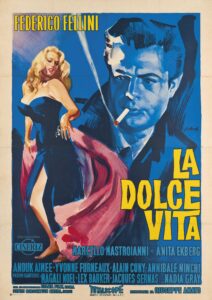From dark until dawn, glamour is restless—1960s Rome knows this best. While the rest of us retreat from our inadequate lives onto beaten mattresses, the elite awakens to carouse in the streets and clubs and high-rises of Italy. Federico Fellini’s La dolce vita (1960) visits several nights of extravagant, vain, and depraved stardom. The “sweet” life has a peculiar aftertaste.
On the partition of a gossip writer and gossip-written, Marcello (Marcello Mastroianni) slithers through the city looking for stories to cover and women to lay. Accompanied by photographer friend Paparazzo (later coining the term “paparazzi,” Walter Santesso), they grab high Roman culture by the article, fame and fortune at the forefront.
Absorbed by the scene, Marcello’s perpetual cycle of days and nights is filled with alluring women, seduced by Swedish-American actress Sylvia (Anita Ekberg), wealthy heiress Maddalena (Anouk Aimée), and the Madonna as sighted in a field by local children.
Over several episodes, Marcello is tossed around in the aristocratic daze further away from his dream of meaningful writing, drowned in orgies, castle rituals, and gaudy entertainment.
What little remains of his dream is visible in distant friend Steiner (Alain Cuny), a loving father, husband, and intellectual. However, after a terrible incident, the dream is finally buried. And so the cycle persists. Back home, his wife sobs over the life he has made for himself, pining equally for a life outside champagne and affairs.
La dolce vita is a chronicle rich in satire and criticism, dedicating all 174 minutes to the ridicule of fame obsession. Intended as a cautionary tale, the film exists now as a precursor to ever-worsening material worship but delivers the message gracefully.
Where the moral is clear, the poetry felt through the film exists only in interpretation. In the case of La dolce vita, a film accredited as one of the very best of all time, I see itemizing my personal translation as reductive to the film’s grandest triumph, transcending its own description for decades.
It is just as easy to say the large fish carcass finalizing the film is the representation of a pompous lifestyle as it is to say the fish is symbolically symmetrical to the statue of Christ from the opening shot. And yet it is just as easy to see the statue, soaring through the sky held by a helicopter, is foreshadow of proceeding sinful stunts. When asking my husband-to-be what he made of this prop, he delivered a distinct interpretation altogether: a device contrasting famed actress Sylvia’s grand entrance from a private plane, embraced by a crowd of photographers and applause. This explanation works just as well as the next.
What is best about the film, aside from many technical excellences, score, cinematography, and performance, is the multi-interpretive narrative, endlessly malleable to the viewer. Decades of appreciation and analysis can only boil down to the individual. The sweet life may not be made for anyone, but the film is tailored to each and every one.

